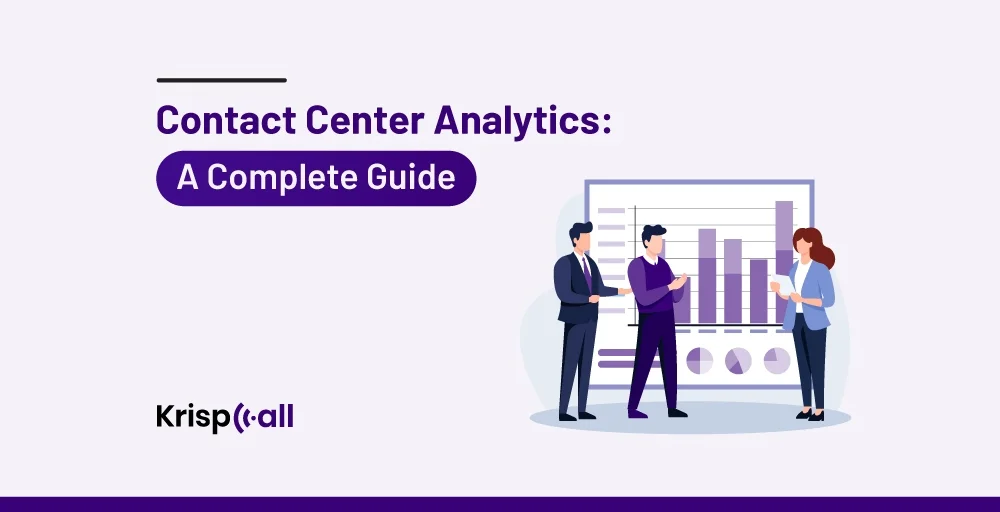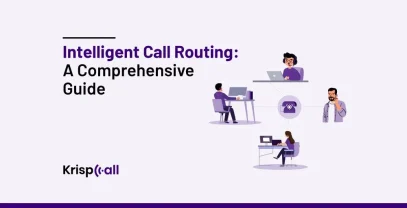Contact center analytics is rapidly changing the way companies interact with their customers. It was possible because of the use of analytical tools. With these tools, enterprises can acquire sufficient knowledge about customers, enhance the quality of services, and increase organizational effectiveness.
According to Contact Center Software Market, the global Contact Center Analytics Market was valued at $72 billion in 2023 and is projected to reach $129.61 billion by 2031, growing at a compound annual growth rate (CAGR) of 8.76% from 2024 to 2031. This growth also proves that there is a growing trend towards the use of data analytics in customer service management.
In this blog, you’ll learn about contact center analytics, its type, use case, top content center analytics software, key analytics features, and best practices.
Let’s get started 👇
🔑 KEY HIGHLIGHTS
- The process of capturing and analyzing data obtained from customer interactions via telephone, email, web chat, and social media is known as contact center analytics.
- Some types of contact center analytics are descriptive analytics, speech analytics, text analysis, interaction analytics, and omnichannel analytics.
- Some top contact center analytics software are KrispCall, Genesys, and NICE inContact.
- Real-time analytics, omnichannel support, customizable dashboard, and scalability are key features of contact center software.
- Setting clear objectives, training staff, regularly updating systems, ensuring data quality, and focusing on customer feedback are some of the best practices for contact center analytics.
What is Contact Center Analytics?
Contact center analytics refers to the process of capturing and analyzing data from customer interactions via phone, email, web chat, and social networks. It also enables organizations to enhance the client experience, improve the performance of their employees, and increase the efficiency of their operations.
When measuring performance in the contact center, companies observe regular figures like AHT (average handle time), CSAT (customer satisfaction score), FCR (first call resolution rate), and others. Such measures assist companies in observing their effectiveness and areas that require enhancement.
This is opposed to contact center analytics, where all interactions can be analyzed instead of a sample to gain the big picture. This assists them in making appropriate decisions that enable the improvement of organization operations and, therefore, make customers more pleasant.
Moreover, with the emerging market of contact center analytics, the industry should expect tremendous increases in financial value. This is because it is effective in easing operations and spicing up the market with better-quality service. Contact center analytics solutions help to make decisions based on statistics, using them for growth and development in this sphere.
Types of Contact Centre Analytics
Different types of analytics used in call centers work together to offer a complete concept that shows how customers interact with the company. Some of the contact center analytics types are discussed below:
- Descriptive Analytics: It is like a school report card reflecting the business’s past performance. It allows organizations to know their strengths and weaknesses, thus strengthening them.
- Speech Analytics: This analytics can be compared to overhearing customers’ conversations to learn how they feel or what they need. This knowledge assists companies in modifying their training processes, learning about customers, and interacting with them in a way that will make them satisfied.
- Text Analysis: It is like reading through the emails and the chatting session to know what customers want. It assists organizations in identifying customer queries, emotions, and issues and enhances the approach to communicating with the customers.
- Interaction Analytics: It is basically speech and text analytics put together to provide the full picture of the customers and their interactions. It enables businesses to see how they are performing, understand trends, and to establish targets that can help them boost their performance.
- Omnichannel Analytics: It is similar to the various touch points clients have with the business through the use of ring, email, and social media platforms. This method helps businesses find out where customers get stuck or confused and provides a seamless customer journey at all touchpoints.
Pros and Cons of Contact Center Analytics
Here are some pros and cons of using call center analytics:
Pros
- Enhance customer relations by delivering relevant and quick services.
- Improve the effectiveness of operations by refining the use of resources.
- Help the organization in making optimal strategic decisions that are achieved through the use of analytical data.
- Provide clear and achievable targets that can be used in identifying and analyzing performance.
- Deliver solutions that are integrated with tools for performing necessary analyses.
Cons
- It has a high initial cost for setup and configuration.
- In implementation, it experienced complexity in operation that required technical work.
- Require people with professional abilities and knowledge to conduct data analysis and draw conclusions.
- It has issues with creating and keeping the focus on individual clients together.
Contact Center Analytics Use Cases
There are several ways that contact center analytics can be applied to benefit business organizations and enhance customers’ experience. Here are five key use cases for implementing contact center analytics:
1. Customer Satisfaction Analysis
Measuring customer satisfaction is one way of determining how effective a contact center is in meeting the customers’ expectations. Through generating feedback and monitoring the various interactions that customers show, one can come up with measures to improve the existing services offered to the client. It enables the organization to come up with the right decision-making that will allow it to have more loyal customers and their retention.
2. Agent Performance Tracking
Tracking and evaluating an agent’s performance can be used to prescribe training and development needs. Contact center analytics software helps companies monitor indicators, including call control time, resolution ratio, and customer satisfaction level. It assists managers in offering appropriate guidance and encouragement to agents, thereby enhancing their performance and the quality of service rendered.
3. Call Steering or Route Intelligence
A contact center analytics solution can be implemented for routing the call to the appropriate agent depending on the customer profile and the agent’s competence. This intelligent routing system improves the customers’ satisfaction by shortening the time spent waiting and optimizes the chances of the first-contact resolution. In this case, customer segmentation entails that customers be patched to the correct agents, which can help increase efficiency and customer satisfaction.
4. Churn Prediction and Prevention
Customer contact analysis will aid in rectifying situations that pose churn and retaining business clients. This way, using predictive analytics, it is possible to identify such signals and patterns that will show dissatisfaction. This helps them to act quickly when a good client is about to leave their business; hence, they are able to adjust their strategies or provide some kind of discount to the customer to make sure that they stay.
Top Contact Center Analytics Software
When selecting the right tools to enhance your contact center operations, it’s essential to explore the top contact center analytics software available. This software will have the necessary insights and capabilities for enhancing performance, increasing client satisfaction, and increasing profits.
1. KrispCall
KrispCall is one of the most preferred contact center software with analytics features available in the market. It provides businesses with extensive analysis tools that enable them to evaluate and optimize their contact center processes. With KrispCall users can analyze past call data for insights into customer interactions and agent performance. It can also be used to get insights from calls to address customer issues.
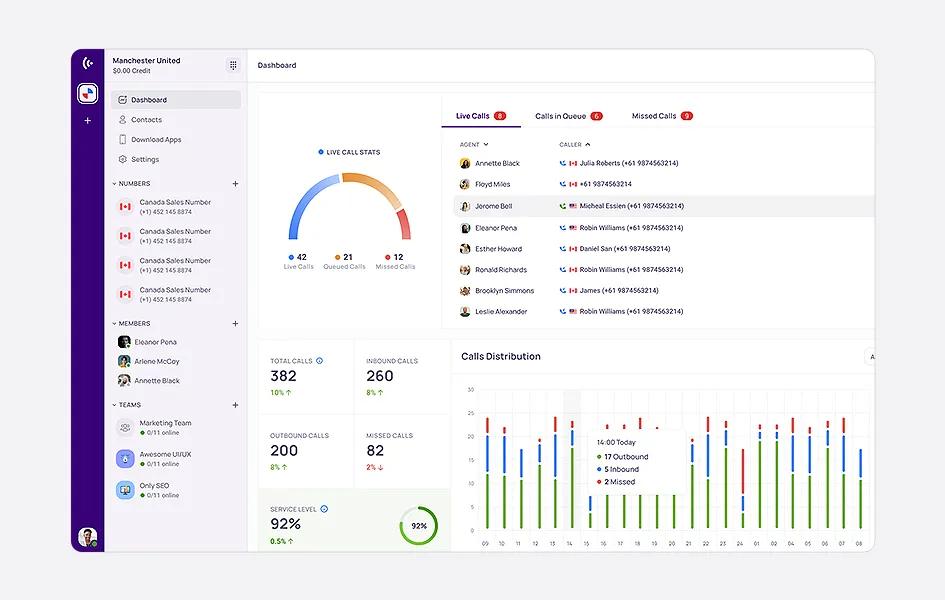
This means that KrispCall’s analytics capabilities empower businesses to make data-driven decisions, improve customer service, and enhance overall call center performance, making it a valuable tool for any organization looking to optimize its telephony strategies.
KrispCall Key Features
- Call volume
- Call duration
- Inbound and outbound call tracking
- Missed calls
- Call recording
💰Pricing
| Plans | Pricing |
| Essential | $15/user/month |
| Standard | $40/user/month |
| Enterprise | Custom |
✅Pros
- Easy integration with CRMs and other tools
- User-friendly interface and easy navigation
- Affordable pricing with enterprise-level functionality
❌Cons
- Only Web App available for macOS and Windows
- Call Barging is unavailable at the moment(Coming soon)
2. Genesys
Genesys has some of the most significant analytics, which helps organizations understand and improve customer experience business processes. It provides an umbrella of solutions that give detailed insight into clients’ engagement through different touchpoints, thus facilitating informed decision-making for organizations and enhancing service delivery.
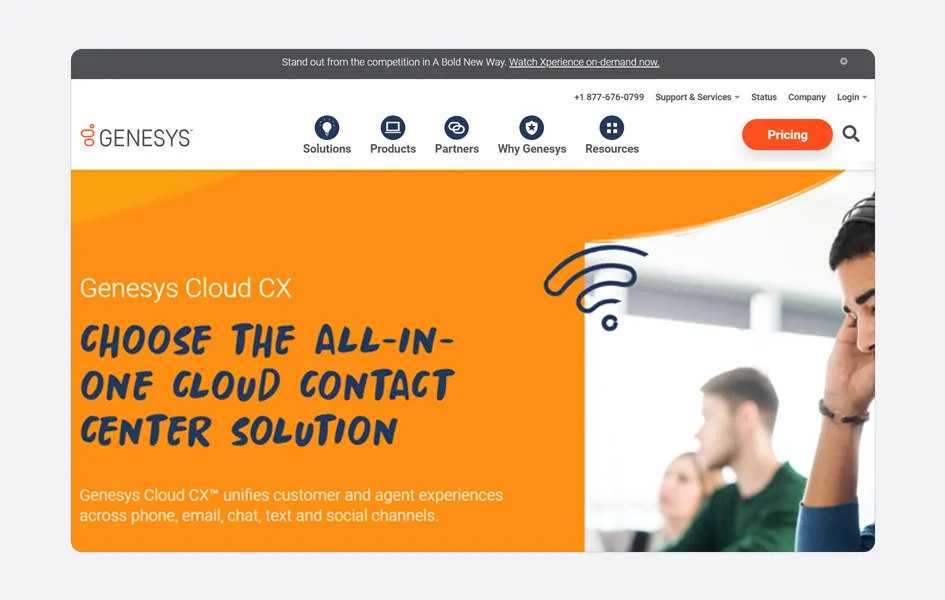
Genesys Key Features
- Omnichannel Support
- Advanced Analytics
- Predictive Routing
- Workforce Management
- AI-Powered Automation
💰Pricing
| Plans | Pricing |
| Genesys Cloud 1 (Voice) | $75/month |
| Genesys Cloud 2 (Digital) | $95/month |
| Genesys Cloud 2 (Digital + Voice) | $115/month |
| Genesys Cloud 3 (Digital + WEM) | $135/month |
| Genesys Cloud 3 (Digital + WEM + Voice) | $155/month |
✅Pros
- Simple and intuitive layout
- Effortless communication with other users
- Can manage options during calls easily
❌Cons
- Poor management and email handling
- Bad post-sale customer support
- Hard to read the call flows
3. NICE inContact
NICE inContact has a fully developed analytics array, which it claims is meant to provide the firm with very detailed information about the various engagements that customers have with the firm and the performance of its agents. It becomes a valuable tool for companies because it can provide important information about the contact center’s performance and ways of improvement, increase agents’ productivity, as well as reduce customer dissatisfaction.
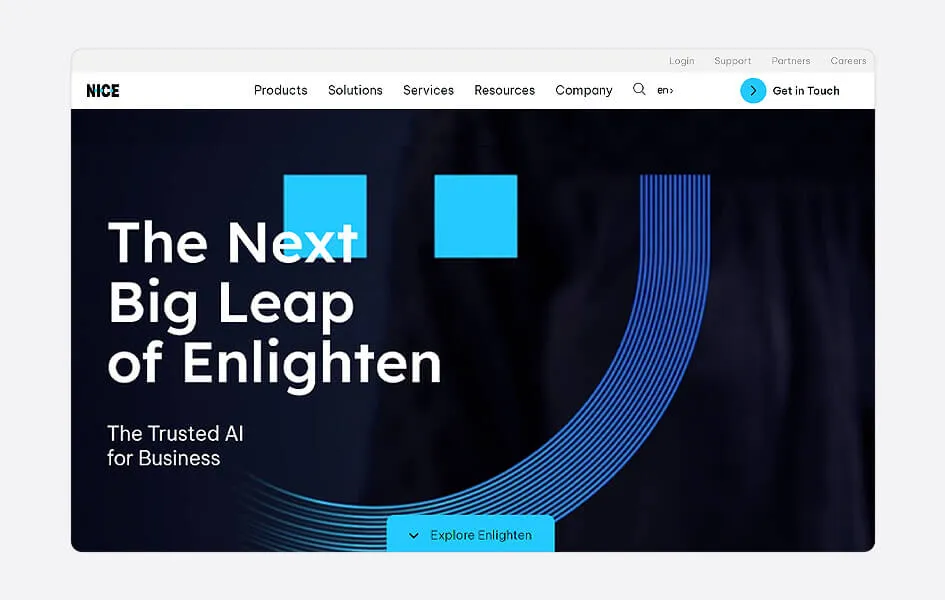
NICE inContact Key Features
- Automatic Call Distribution
- Interactive Voice Response
- Workforce Management
- CXone Automation and Artificial Intelligence
- Call Center Analytics & Reporting.
💰Pricing
Contact the Sales team
✅Pros
- Simple to customize, integrate, and set up.
- Various reporting options, including charts.
- Great call-tracking features, showing hours and minutes spent.
❌Cons
- Slow to react and hard to make big changes
- Sometimes, poor audio quality causes problems
- Unable to answer some calls as they get stuck
Key Analytics Features to Look for in Contact Center Software
When choosing contact center analytics software, prioritize features that go along with your business objectives and allow you to make data-informed decisions. So, here are the five analytics features to look for in your contact center software:
1. Real-time Analytics
Some contact center analytics software offers real-time analytics, which means that you can analyze your data as soon as it is collected. This provides real-time information that enhances quick decision-making and usually brings out the best performance. Real-time analytics help to find problems and solve them as they occur in the contact center so that the center can perform optimally.
Real-time analysis can also help quickly adapt to new trends and patterns observed in business. This improves the chances of making the right decisions regarding data and customer experiences. It is, therefore, easier to make decisions and manage poor-performing products, thereby resulting in better business outcomes.
2. Omnichannel Approach
Omnichannel support in contact center analytics software facilitates smooth interaction with customers. This feature assists your agents in finding the essential information and offering the fitting solution irrespective of the channel used. Thus, choosing an omnichannel strategy allows you to eliminate structural barriers and improve the continuity of the sales process.
Omnichannel support is crucial since it will allow the organization to provide consistent communication to customers across different platforms, such as social media platforms, emails, and chats. This feature is highly useful as it allows for better and more efficient interaction with customers. With such information, which is collected from different points of touch, it will be easier to help customers and increase their loyalty.
3. Customizable Dashboards
Customer center analytics solutions can include options such as customizing a contact center’s dashboard to suit your KPI priorities. This feature allows you to arrange layouts, widgets, and metrics according to users’ needs so that important data can be accessed quickly.
That is why, when you have your own customized and individual dashboards, you can enhance your efficiency. They assist you in making patterns, searching for opportunities, and even noticing what needs the most attention. Using customizable dashboards, you can work with the data and transform your business for the better.
4. Integration Capabilities
Contact center analytics systems that offer integration features work well with other applications, including CRM, ERP, and marketing automation platforms. This feature allows users to combine data from various sources, which can help them better understand customer preferences and needs.
When connected to other applications, such processes help prevent data isolation and improve communication between various systems within the contact center environment. This feature assists in making the right decisions based on the data and reaching a new level of business evolution. When a business has integration capabilities, it has a better picture of its customers and hence can better deliver on customer experience.
How Do You Analyze Data in a Contact Center?
Data analysis in a contact center requires various processes. First, data must be gathered from different sources. Then, that data must be refined and prepared for analysis.
After that, data is analyzed using various statistical tools to draw insights. These insights are then reported to stakeholders in a clear and concise manner, and finally, action is taken based on the insights to drive performance improvement and informed decision-making.
Let’s understand this in steps:
- Data Gathering: Accumulate data from various collaboration platforms.
- Data Cleaning: Refine and arrange the collected data for analysis.
- Data Analysis: Draw insights from the data using analysis tools and methods.
- Reporting: Prepare and present a report to stakeholders summarizing findings.
- Reporting and Action: Make changes based on insights to enhance performance.
Key Metrics of Contact Center Analytics to Track
One must keep track of top call center key metrics to monitor contact center performance and improve customer experience. So, here are some key metrics of contact center analytics you should keep track of:
1. First Call Resolution (FCR)
First Call Resolution (FCR) means how many customer concerns are handled in the first call such that there is no need for the customer to call again. A high value of the FCR rate means that the agents are capable of solving most of the customers’ problems at the first point of contact, hence improving overall customer satisfaction and also reducing operational expenses.
2. Average Handle Time (AHT)
Average Handle Time (AHT) is the total time spent from the start of the call until its completion, including the talking time, time spent on hold, and time for completing post-call activities. AHT is thus useful in measuring the efficiency of agents and also useful in finding areas where costs can be cut in the process. Through decreasing AHT, companies enhance the capacity of their agents, taking more calls and raising the level of customer satisfaction.
3. Customer Satisfaction Score (CSAT)
Customer Satisfaction Score (CSAT) measures whether the customer is satisfied or not with the kind of service received by completing a survey form. CSAT generates useful information concerning the quality of customer service that lots of organizations need to know concerning their service approaches to customers. A higher CSAT score is a sign that customers remain satisfied with the service and are more likely to stay loyal.
4. Net Promoter Score (NPS)
Net Promoter Score (NPS) is used to evaluate customers’ recommendations of a service, taking into account their loyalty and level of satisfaction. NPS is a useful tool for measuring client satisfaction and estimating business revenues, as loyal customers supply more profits due to their repeated visits and recommendations. This is true because any service organization with a high NPS score means customers are satisfied and willing to refer others to use the service.
5. Call Abandonment Rate
The Call Abandonment Rate is defined as the percentage of customers who disconnected their call before being connected to an agent. Thus, a high abandonment rate may suggest that customers are being forced to wait too long on the phone, there are not enough operators or agents to handle the call volume, or the strategies applied to handling calls are unsuitable. By addressing the abandonment rate, different types of businesses are therefore able to enhance customer satisfaction and increase their revenues by not losing their potential sales.
Contact Center Analytics Best Practices: How to Use it to Improve Your Business?
In order to effectively use contact center analytics to improve your business, you should be willing to follow best practices that enable better data utilization. This will ensure that you generate valuable insights that can be acted upon.
- Setting Clear Objectives: To achieve the best results, it is necessary to determine clear objectives when using analytics. This requires having measurable objectives like increasing customer satisfaction or decreasing churn rates and having the metrics that will indicate how progress is being made. When goals are clearly defined, analytics is more effective in driving business value since resources are directed on what is important to meet organizational objectives.
- Training Staff: Staff must be trained since they will be using the analytics tools and evaluating the information obtained from those tools. Other staff support involves ensuring that the staff is trained with updated information on the current type of analytics in the market. Sufficient qualified employees ensure they obtain useful information and knowledge from data to improve organizational performance.
- Regularly Updating Systems: The other key factor we find worthy of consideration is the need to update the analytics systems and tools regularly. This involves posting new software updates, adding new data input sources, and adding new capabilities or options. This way, businesses will remain relevant and competitive and ensure that their systems and analytics needs are met appropriately.
- Ensuring Data Quality: Data quality is crucial so that the conclusions and insights generated are accurate. This entails adopting procedures that make the data accurate and complete and also practicing data validation and data cleaning on a frequent basis to eliminate errors and inconsistencies in the collected data. This way, businesses can remain assured about the accuracy of their insights coming through analytics and confidently make the right decision.
- Focusing on Customer Feedback: Customer feedback is an important aspect that business organizations can use to enhance their products or services and even the overall customer experience. Thus, businesses can consider the voice of the customer as a primary source of data and feedback to find opportunities for improvements, specify priorities, and evaluate the outcomes of activities. This makes it possible for businesses to offer a far more specialized experience that corresponds to the new demands of the consumers.
Conclusion
Contact center analytics is an effective solution that enables businesses to enhance customer relations, increase performance, and make the right decisions. Therefore, it is important for companies to incorporate contact center analytics software in their business to effectively understand the flow of communication between customers and agents and the effectiveness of service delivery. This makes them know when they need to change and where to change in particular, and generally work with facts.
In some ways there are challenges associated with implementing contact center analytics solutions, but the advantages outshine the disadvantages. When working with contact center analytics, it is possible to follow several rules: define clear objectives for the contact center’s activity and mainly focus on customers or clients. As competition in the market of contact center analytics increases, the adoption of such data will be vital for organizations to sustain competitiveness and address customers’ new demands.

